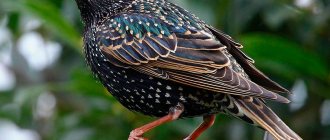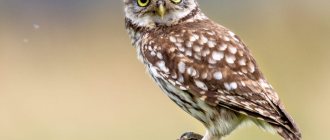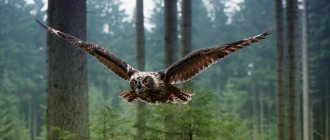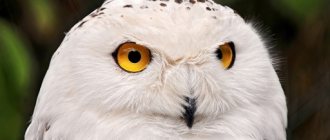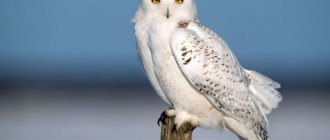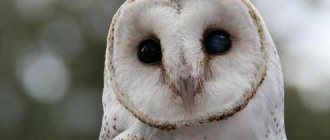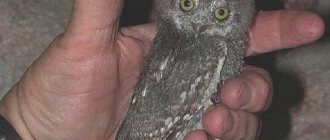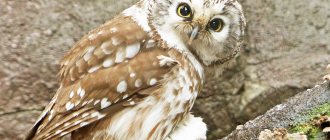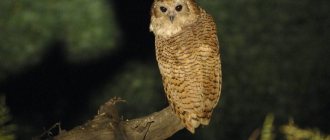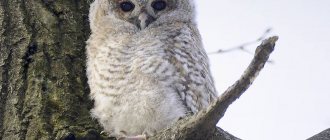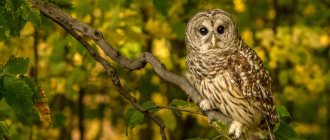- Wild animals
- >>
- Birds
Asio otus or long-eared owl is a small bird belonging to the owl family. This species is characterized by rather long feather tufts on the sides of the head; they look like small ears. Owls of this breed have a uniform color. Long-eared owls live in forests, small copses and city parks. Birds of this species are migratory birds; they fly in groups of 10 or more individuals. Long-eared owls are quite difficult to meet, since owls do not fly during the daytime and are nocturnal. They differ from other owls not only in their feathered “ears” but also in their character and elements of behavior.
Origin of the species and description
Photo: Long-eared owl
Long-eared owl Asio otus. Owl order. Genus of long-eared owls. Species Long-eared owl. Owls have quite ancient origins. At the beginning of the Cenozoic era in the Eocene, these birds already inhabited the ancient forests of America, as evidenced by the ancient fossils of these birds found by scientists. Many extinct birds belonged to modern genera. The barn owl lived during the Miocene period, eagle owls have been known since the late Eocene.
Video: Long-eared owl
Ancient owls were very different from modern birds; they were not predators, and had behavioral differences. Over many years of evolution, birds of this species have developed their own specific style of hunting. Owls do not chase their prey, as other birds do, but lie in wait for their prey and quickly attack it. Today, owls are a well-separated group of birds in all respects. Systematically, owls are related to nightjars, rickshaws and parrots.
The species Asio otus was first described by the Swedish naturalist and scientist Carl Linnaeus in 1758. This species has some features that distinguish long-eared owls from other representatives of this species. Long-eared owls have a pronounced facial disc; rather high feather tufts, which are called “Ears,” are noticeable on the bird’s head. Owls of this species have narrow and stiff feathers and a beautiful “marbled” color.
Why is the tawny owl called that?
The word itself takes roots in Ancient Greece and is found in Old Russian and church languages. But the origin has not been fully determined.
The gray owl (common) lives in Russia
Some philologists believe that “tawny owl” means “not satiating oneself,” while others mean “insatiable.” A synonym is the word “gluttonous.” Dahl's Explanatory Dictionary states that the name means “a type of eagle owl, a fabulous, insatiable bird.”
In the dictionaries of the Middle Ages, a number of birds were called tawny owls - pelicans, kites, owls, crows. It is assumed that, translated from Church Slavonic, the word should be understood as “not food, not food,” that is, “an animal that is not eaten.” This is due to the fact that the Bible refers to the tawny owl as an “unclean animal.”
This is interesting! The owl has been considered a symbol of wisdom since ancient times. The Greeks and Romans depicted birds next to deities.
Appearance and features
Photo: Long-eared owl bird
Males and females of this species do not have any special external differences. The bird's head is large and round in shape. The iris of the eyes is yellow or orange. The bird's facial disc is edged with dark feathers. The owl has hard dark feathers around its beak and light feathers around the chin. On the forehead between the feather fluffs there are marble-colored feathers.
There are several rows of black feathers around the eyes. The ear tufts consist of three or five brown feathers; on the outside the feathers have a reddish tint. On the neck and back the plumage is red, with brown spots. The spots do not merge into one pattern. About 4 black stripes are visible on the lower part of the bird's body. The flight feathers have 4 brown spots on the feathers and on the inside.
Young birds have the same color as adults, only their feathers are softer. A brown spot stands out 7-10 centimeters from the fold of the wing. The wingspan of an adult owl is 87-100 cm. The bird reaches 32-40 cm in length. In this species of birds, males are approximately 1–5% smaller than females. Externally, birds of different sexes are not very different.
Birds' wings are long and rounded. From behind, when the bird sits, the feathers overlap each other a little. The tail of owls of this species is quite long, rounded and consists of 12 tail feathers. The claws and beak are brown. The beak is sharp, rounded. The soles of the feet are grey. Long-eared owls live quite a long time; under normal conditions, an owl can live up to 25 years.
Interesting fact: An owl changes several outfits during its life. The plumage of down gives way to mesoptile, and by the second year of life permanent plumage begins to form. Owls moult annually.
Seasonal dormouse: which animals have to hibernate for the winter (2 photos)
What animals hibernate in winter
Actually, hibernation or hibernation is the genetic adaptation of the body to temperature changes. This condition is characterized by a slowdown in all vital processes, metabolism, pulse, and breathing. Hibernation is preceded by quite a long and serious preparation. So, they go to bed for the winter:
- Marmot. The expression “sleeping like a woodchuck” was invented for a reason. It clearly expresses the characteristics of these animals, capable of sleeping for up to 9 months a year. Marmots are active and mobile animals, but before hibernating they eat a lot and walk little. Having sealed the entrance to the “bedroom”, the family goes to bed with a sense of accomplishment. The animals' heart rate drops to 3-5 beats per minute, and their body temperature can generally drop to zero.
- Bear. This, naturally, is an unsurpassed record holder in the animal world for sleeping. Only three of the existing species go to winter rest - brown, Himalayan and black. Their sleep is rather superficial and sensitive. Body temperature remains virtually unchanged, like all life processes. A bear awakened prematurely is very angry, aggressive and dangerous. The connecting rod can wander through the forest until spring, wastefully using up previously accumulated fat reserves.
- Hedgehog. The main food of spiny stompers is insects. And with them in the winter, for obvious reasons, it’s tense. Therefore, hedgehogs have to go to bed in the fall, having previously accumulated fat, and in their sleep wait for the arrival of spring.
- Gopher. Like marmots, they are able to spend up to 9 months of the year sleeping. For the winter, gophers carefully block the entrance to the hole with earth, leaving a small branch that almost reaches the surface of the earth to ensure safety. After awakening, they experience a short period of vigorous activity.
- Badger. As in the case of bears, the sleep of these minke whales is sensitive and is not accompanied by a slowdown in the main life processes in the body. Before hibernation, badgers accumulate a significant fat reserve and gain almost twice their normal weight. When the snow cover becomes constant, they stop leaving the burrow. They get to the surface only when the temperature becomes positive.
- Hamster. They are capable of falling into a kind of stupor if the air temperature drops below +10 degrees. But this state cannot be called full-fledged hibernation, since while life processes slow down, relative activity remains. In this form, hamsters can spend several hours, devoting the rest of the time to searching for food.
- The bats. Not all representatives of bats hibernate for the winter. This is determined by the climate and the specifics of the habitat. If in winter the temperature drops below zero, then bats look for caves or other secluded places to sleep, or migrate to more comfortable living conditions. Mice sleep, wrapped in their wings, for up to 7 months a year. In severe frosts, unfortunately, they can even die in their sleep, since the body temperature drops to 10 degrees compared to the usual 40 in the active state.
- Echidna. The native Australian does not tolerate both cold and heat equally well, since the animal does not have sweat glands, and the body temperature is approximately 30 degrees. In severe cold weather, they can hibernate for up to 4 months.
Where does the long-eared owl live?
Photo: Long-eared owl in the Moscow region
The habitat of the long-eared owl is quite extensive. These are Eurasia, Finland, Western Scandinavia. In the south it is Palestine, Iran, the Pamirs and the southern part of Altai. They often nest in the Nanypan Mountains and eastern Tibet. Birds also live in Southern Arizona, Oklahoma, Virginia, Northern California, Scotland, and North America.
Long-eared owls inhabit islands such as the Canary, British, Azores, Japanese, and Sicilian Peninsula. They are found in large numbers in Armenia; they like to settle in the mountainous regions of the Tien Shan, where these birds like to spend the winter. They can settle in the mountains at an altitude of up to 2 thousand meters above sea level.
In Russia, birds of this species can be found almost throughout the country. Owls settle in tall forests in the Perm, Orenburg regions, Krasnoyarsk, Moscow, Tula, Lipetsk, Oryol, Kursk and other regions. It has also been noticed that in St. Petersburg and its region, birds sometimes remain for the winter.
In addition, owls of this species live in the Caucasus, Armenia, Uzbekistan, and Georgia. Long-eared owls are migratory birds. These birds arrive in central Russia at the end of March - April. In autumn in September, owls fly to warm countries for the winter. Owls nest in mixed forests, parks, and bushes. They often occupy old nests of birds of prey.
Which owls are diurnal?
The habitat plays a decisive role in the behavior of owls. Thus, the hawk owl, unlike many of its fellows, leads an active lifestyle at night and during the day. This is largely explained by the fact that its habitat is the northern regions. The bird hunts small rodents that hide under the snow, and if their numbers are insufficient, it targets larger animals: hares or stoats.
Snowy and northern pygmy owls and taiga sparrow owls do the same.
Taiga pygmy owl
The former in tundra conditions, especially when polar days begin, are active around the clock. The food of the latter is songbirds, and they are awake only during daylight hours.
The behavior of other representatives of owls may also be atypical. Although most of them actually sleep during the day or simply sit out in the trees, sometimes in winter or in cloudy weather some of them fly out to hunt during daylight hours.
Eagle owls, for example, see perfectly in daylight even at great distances. For little owls, there is also no fundamental difference when to hunt.
What does the long-eared owl eat?
Photo: Long-eared owl in Russia
The diet includes:
- mice, voles and other rodents;
- small passerine birds (brambling, goldfinch, sparrow, bindweed);
- beetles (May beetles, Khrushchi beetles, longhorned beetles, dung beetles, mole crickets and others);
- small squirrels, rabbits;
- moles;
- shrews;
- stoats;
- the bats;
- frogs and other amphibians.
In different regions, the diet can vary greatly; in some places owls may feed only on rodents, in others, on the contrary, birds eat more beetles and insects. Sometimes owls can attack even fairly large birds - partridges, pheasants, and rooks. Birds make up about 10% of the owl's diet; birds more often feed on rodents; they can make up up to 80% of the diet. Undigested food remains in the form of bones, feathers and fur are regurgitated by the bird.
Depending on the biotype in which the owl lives and its noise level, owl hunting occurs differently. In the forests, owls watch their prey on tree branches. The bird is located on branches 3-5 meters from the ground and tracks its prey, choosing the time when the victim is distracted by something, the owl sharply attacks it. In open areas, owls use search flights to hunt. The bird slowly circles above the ground and is looking for something to eat. Sometimes they watch for prey from the ground. On calm, windless nights, owls mostly fly, at a height of about 3 meters above the field. If it rains and in windy weather the birds hunt from perches.
Keeping at home
You can have an owl as a pet if you are willing to provide the bird with its vital needs. A night hunter will want activity from evening to morning, so the bird will not let its owner sleep.
To feed, owls need whole carcasses of rodents or birds; meat just won’t do. Not every owner will be internally prepared for this. Birds need enough space to not sit in a cage, spread their wings, and sometimes fly. Eagle owls, tawny owls and other large birds are not suitable for keeping in an apartment.
The owl in the photo always attracts attention with its attentive gaze. Owners of tame birds note their intelligence, playfulness, vitality, and curiosity. You should only buy an owlet from a nursery, since the markets often sell individuals caught by poachers.
Wild birds are often unhealthy, so you can bring the infection into the house and be left without a pet. Diseases in birds develop rapidly. Only a competent approach and sincere care will ensure the health and well-being of the owlet.
Features of character and lifestyle
Photo: Long-eared owl bird
Owls are nocturnal birds. During the day, long-eared owls sleep peacefully sitting on branches, while trying to be invisible by hiding in the foliage. At night they go out hunting. During nesting, birds occupy nests at a distance of about 100 meters from each other. During the non-breeding period, birds gather in small flocks of 5 to 60 individuals. During the day, such flocks can occupy thickets of bushes or tall coniferous trees. In such flocks, birds feel safer and can rest peacefully. In the evening, birds fly away to feed within half an hour after sunset. Feed more often alone.
Interesting fact: Long-eared owls have as many as three pairs of eyelids, some are used during flight to protect the eyes from dust particles and midges, others for blinking, and others for sleeping.
Long-eared owls are not afraid of humans, but can behave quite aggressively if disturbed, especially during the nesting period. If you approach an owl, it begins to hiss and fluff up its feathers, and may bite if it does not want to be touched. The birds are relatively calm; there are usually no clashes in the flock. Birds do not particularly protect their territory; they do not build nests, but settle in the old nests of other birds.
Long-eared owls are migratory birds. They usually winter in the same places. Birds fly away for the winter at the end of August - September. They return to their usual habitat at the end of March - April, depending on the climate, the timing may vary slightly.
How long do owls sleep? So what should I do? And is it necessary?
So, dear adequate owls (who sit until 2 o’clock), crazy owls (until 3 am) and completely fucked owls (who sit until the morning), I have not the best news for you. Being an owl is not a natural given, we all deceived. This is a disease that we have carefully cultivated for ourselves over the years of our lives. Fortunately, it is curable. Why is the disease? There is such a thing as circadian rhythms, i.e. internal biological clock, in owls there is a violation of the synchronization of these same clocks with the real clock. With this lifestyle, there is increased wear and tear on the nervous system, which means we spend our health much faster, which can come back to haunt us very seriously in old age. Yes, and we don’t live to the fullest: either we slept too much and have a headache, or we didn’t get enough sleep, the average rarely happens. The reason that this happens is, of course, promiscuity and lack of self-discipline. Our body does not receive signals that “night has come” due to artificial lighting and therefore does not trigger the production of melatonin (sleep hormone), and we go to bed simply because of fatigue. And if there is no severe fatigue, then when we When we go to bed, we can’t fall asleep for a long time. But as? We have been training this in ourselves for so long, the body simply does not produce melatonin when it is needed. There is such a medical diagnosis: a violation of circadian rhythms with late triggering of the initial phase of sleep. Treatment is as follows: 1. Realize and accept that you DO have this disorder, and that you need to work with it.2. We need to re-adjust this rhythm so that melatonin production begins at 21:00, and sleep is closer to midnight at least. You need to go to bed at 22-23 and get up at 7-8 am on all days, regardless of whether it is a workday or a day off. How to do this? 1. At 21:00 we take a drug containing melatonin (Melaxen, for example), this is an over-the-counter drug, an artificial version of the hormone melatonin, which we do not produce ourselves.2. At 22-23 o'clock we definitely go to bed. Before going to bed, it is better to read something, not to do anything that can somehow excite or accelerate the psyche. We make the lighting in the entire apartment dim starting from 19-00. In our case, the melatonin taken will be our crutch for the first time; it will help us pass out. When you fall asleep, your body will begin to produce its own melatonin.3. We make sure to wake up at 7 am and do something interesting. We need a powerful lighting source, at least 2500 lm. In the morning we must turn on a VERY BRIGHT LIGHT and we must see this light for at least an hour. Thus, the brain understands that the day has come and turns off the production of melatonin in the body and cheerfulness appears, drowsiness goes away.4. We forget about coffee and tea after 14-00, leave it in your past life. Normal people who don’t have rhythm disturbances can, but you can’t, accept it and come to terms with it.5. Throughout the following During the day we adjust the lighting in the apartment, after 19-00 the lighting everywhere should be semi-dark, we close the curtains. This is all that is needed to cure circadian rhythm disturbance once and for all, you may need to force yourself to do this for several weeks, and then a new normal habit will appear. The melatonin drug can be discontinued in a couple of weeks, don’t be afraid, you won’t develop a habit of it, PROVIDED that you use it to adjust your rhythms, and not to pass out and then sleep until noon. Due to the fact that you wake up EARLIER, you will gradually accumulate a certain “reserve”, so to speak, of the desire to go to bed in the evening, and not late at night or in the morning. Let's all together stop being different breeds of birds and be healthy!
Social structure and reproduction
Photo: Long-eared owl chicks
The nesting period for long-eared owls begins in March and early April. During nesting, birds behave in a special way; they emit a leisurely cry “goo-goo-goo”, this cry is repeated every five seconds. Birds call their partner to the mating flight with a cry, which is accompanied by the flapping of their wings.
Interesting fact: Long-eared owls are not known for their homelike behavior; they do not build nests at all, but occupy the old nests of crows, magpies and rooks. Sometimes they can create a clutch even on the ground among the grass. The nest is usually used for one season, only for breeding.
A bird of this species can lay from 3 to 9 eggs during one mating season. The female lays eggs at intervals of several days. The clutch is incubated and guarded by one female. During incubation, the female flies away from the nest at night 5-8 times per night in order to find food for herself. The female constantly turns the eggs; the bird turns the eggs 40 times per day, for what purpose this is done is unknown. The chicks hatch after 25-28 days. Hatching lasts for about a week; the chicks from the last clutch are born later.
Chicks are born with a body weight of 14-21 grams. Little owlets are covered with white fluff, they are blind and absolutely helpless. They make squeaking and chirping sounds. The eyes of the owls open on the fourth day of life. It has been noticed that chicks from the first clutches develop much faster, but over time the younger brothers catch up with the development of the older ones. By the end of the first month of life, the bird’s growth stops. A young owl becomes very similar to an adult bird, the only difference being the plumage. Plumage development will end around 50 days of age.
After the birth of the offspring, the female warms them and stays with them all the time. The male brings food to the family. During the daytime, the male and female rest near the nest. If a person approaches the nest, the birds begin to actively drive him away by hissing. Sometimes they can even attack a person. The owlets begin to leave the nest at the end of the first month of life, they begin to fly to neighboring trees. However, at this age, the chicks are not yet able to obtain food, and their parents feed them. At 10 weeks of life, the chicks leave the nest without even learning to fly. Birds reach sexual maturity at one year of age.
Now you have seen what a long-eared owl chick looks like. Let's see who is hunting this bird?
How our owl spent the winter
Original taken from
osvejimsya
in How our owl wintered
The story of how an owl overwintered at our house
1. In September, while walking near the house, I suddenly saw an owl lying in the grass! The bird lay with its wings slightly spread and practically did not move, only turning its head in my direction and clapping its huge eyes.
2. When I tried to pick her up, she desperately resisted, trying to scratch her with sharp claws and peck her. Somehow I stuffed her into a cardboard box and took her to the vet.
3. The doctor was a little surprised and carefully examined the bird. The bones are intact, but two wounds were found on the right wing. It looks like the owl hit something hard while flying. The wound was disinfected and a 5-day course of antibiotics was prescribed. The doctor said that the owl is very weak and needs to be fed well.
4. In nature, owls eat small rodents, in our area, mainly mice. I immediately called a biologist friend who works with laboratory mice and outlined the situation. A few hours later I had at my disposal three dead mice from the vivarium of one of the local research institutes.
I threw the mouse into the box, but quickly realized that the owl was too weak to eat it whole. It became clear that the mouse needed to be cut at least in half. Overcoming disgust and disgust, I put the unfortunate mouse on a small cutting board and cut it into two parts with a kitchen knife. But the weakened bird did not have enough strength even to move its head.
5. She just lay there and watched. Sometimes she clicked her beak out of fear.
6. Now I will show how I had to feed a weak bird during the first few weeks.
First, I took the frozen mouse out of the freezer. That's where I had to store them to avoid damage.
7. Defrosted the frozen mouse in hot water for 10-15 minutes.
8. Then he placed it on a small cutting board specially designated for this purpose.
9. And cut it into small pieces that the owl could swallow. The first time it was not easy for me, because... the contents of my own stomach begged to come out, but quite quickly I got used to it and prepared my meal at the same time as the owl.
10. I fed with tweezers.
11. The owl got stronger very quickly from such tasty and healthy food. Within a week he could sit on the perch independently.
12. And he began to eat sitting down, like a gentleman.
13. After another week, he began to spread his wings and try to fly. I had to let him out of the cage and give him an apartment at his disposal. I only had enough strength to run across the floor and flap my wings. Here he is sitting under the table. And one day I had to get it out from under the sofa.
14. Meanwhile, I acquired live mice. The difference between a live mouse and a defrosted one is about the same as between fresh meat and last year’s can of stew. What do you prefer?
15. In addition, owl hunting is very interesting.
I used the empty cage as a dining table for my owl. At the appointed time, usually in the evening, the mouse was brought to the table.
16. The little owl, usually sitting on the cabinet, immediately dived for prey.
First, he grabs the mouse with his claws and strangles it for about half a minute.
17. Then, starting from the head, bites off pieces and swallows.
18. Then swallows the back part.
19. It’s very funny when only the tail remains sticking out.
20. Using live mice, the baby owl recovered completely. His favorite pastime was running circles around the apartment at night. In general, owls are active at night and prefer to sleep during the day.
Birds of prey have a very interesting digestion system. The fact is that a swallowed mouse cannot be completely digested. The fur and bones are regurgitated in the form of a rounded lump (pellet) approximately 8-12 hours after ingestion. The weight of a laboratory mouse is approximately 25 grams, the weight of a pellet is 2-3 grams.
22. In general, the long-eared owl is very artistic. It’s not me who is curiously looking at me from the closet.
23. And here he gets angry
24. Owls have very interesting eyelids. They are double layered. One is a thin film that covers the eye at an angle to the horizontal. The second is dense, with fluff. In addition, the owl can blink its eyes individually.
25. One day, a biologist friend, Marina, came to visit and spoke in detail about the insides of mice. It turns out that their intestines are up to half a meter long.
26. Many people asked me what I named the owl. I don't think it was necessary to name him. After all, why do they give names to dogs, for example? So that when you go out into the yard, you can call out your “Ball” or “Bug”. There is no such problem with the owl, she is alone and there are no other owls around. That's why the little owl was called the little owl. Well, or an owl.
27. Sovchishka is surprised
28. Guilty owl in the wardrobe
29. Once I noticed that one mouse had become noticeably larger than the others. I put it in a separate container. A couple of days later she gave birth to 12 little mice.
30. Within a few days they were covered with fur. They latched on to their mother with such force that she had difficulty tearing herself away from them.
31. Meanwhile, winter is long over
32. And one day something happened that was bound to happen sooner or later. On a warm April evening, an owl flew out of a window left open. It was sad, after 7 months we got very used to this ridiculous and funny creature. I hope that everything is fine with him now and after illness and a long winter he is again living a full bird life

